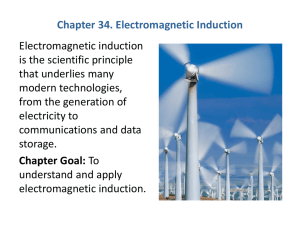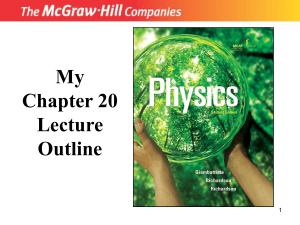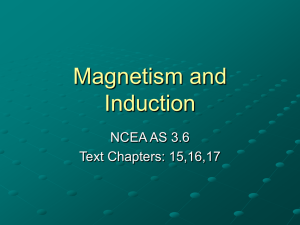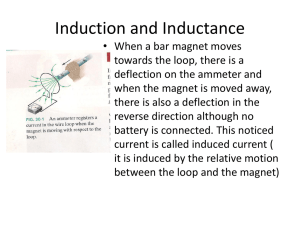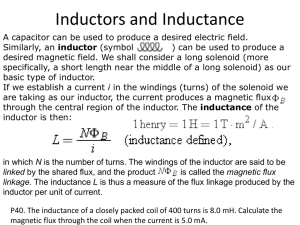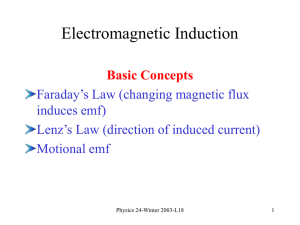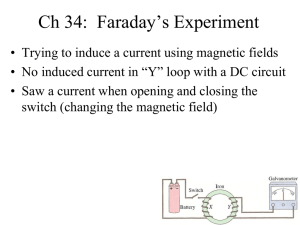Document
advertisement
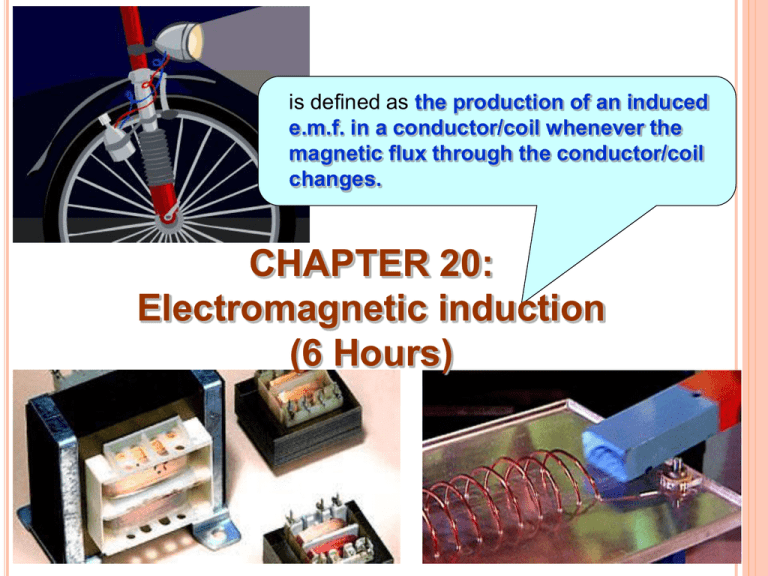
is defined as the production of an induced e.m.f. in a conductor/coil whenever the magnetic flux through the conductor/coil changes. CHAPTER 20: Electromagnetic induction (6 Hours) 1 LEARNING OUTCOME: 20.1 Magnetic flux (1/2 hour) At the end of this chapter, students should be able to: Define and use magnetic flux, B A BA cos 2 20.1.1 Magnetic flux of a uniform magnetic field is defined as the scalar product between the magnetic flux density, B with the vector of the area, A. Mathematically, Φ B A BAcos where (7.1) : magnetic flux : angle between the direction of B and A B : magnitude of the magnetic flux density A : area of the coil 3 It is a scalar quantity and its unit is weber (Wb) OR tesla meter squared ( T m2). Consider a uniform magnetic field B passing through a surface area A of a single turn coil as shown in Figures 7.2a and 7.2b. B A area Figure 7.2a From the Figure 7.2a, the angle is 0 thus the magnetic flux is given by Φ BAcos BA cos 0 maximum BA 4 A B 90 area Figure 7.2b Note: From the Figure 7.2a, the angle is 90 thus the magnetic flux is given by Φ BA cos BA cos 90 0 Direction of vector A always perpendicular (normal) to the surface area, A. The magnetic flux is proportional to the number of field lines passing through the area. 5 Example 1 : A single turn of rectangular coil of sides 10 cm 5.0 cm is placed between north and south poles of a permanent magnet. Initially, the plane of the coil is parallel to the magnetic field as shown in Figure 7.3. N S R I Q I S P Figure 7.3 If the coil is turned by 90 about its rotation axis and the magnitude of magnetic flux density is 1.5 T, Calculate the change in the magnetic flux through the coil. 6 Solution : B 1.5 T The area of the coil is Initially, Finally, A From the figure, = thus the initial B magnetic flux through the coil is B A From the figure, = thus the final magnetic flux through the coil is Therefore the change in magnetic flux through the coil is Φ Φ f Φ i 7 Example 2 : A single turn of circular coil with a diameter of 3.0 cm is placed in the uniform magnetic field. The plane of the coil makes an angle 30 to the direction of the magnetic field. If the magnetic flux through the area of the coil is 1.20 mWb, calculate the magnitude of the magnetic field. Solution : The area of the coil is 8 Solution : The angle between the direction of magnetic field, B and vector of area, A is given by Therefore the magnitude of the magnetic field is 9 LEARNING OUTCOME: 20.2 Induced emf (2 hours) At the end of this chapter, students should be able to: Use Faraday's experiment to explain induced emf. State Faraday’s law and Lenz’s law to determine the direction of induced current. d Apply formulae, dt Derive and use induced emf: I) in straight conductor, lvB sin dB ii) in coil, OR dA A iii) in rotating coil, dt B dt NAB sin t 10 20.2.1 MAGNETIC FLUX 20.1.1(a) Phenomenon of electromagnetic induction Consider some experiments were conducted by Michael Faraday that led to the discovery of the Faraday’s law of induction as shown in Figures 7.1a, 7.1b, 7.1c, 7.1d and 7.1e. v0 No movement Figure 7.1a 11 v S N I Move towards the coil I Figure 7.1b v0 No movement 12 Figure 7.1c v N S I Move away from the coil I Figure 7.1d v S N Move towards the coil I I 13 Figure 7.1e From the experiments: When the bar magnet is stationary, the galvanometer not show any deflection (no current flows in the coil). When the bar magnet is moved relatively towards the coil, the galvanometer shows a momentary deflection to the right (Figure 7.1b). When the bar magnet is moved relatively away from the coil, the galvanometer is seen to deflect in the opposite direction (Figure 7.1d). Therefore when there is any relative motion between the coil and the bar magnet , the current known as induced current will flow momentarily through the galvanometer. This current due to an induced e.m.f across the coil. Conclusion : When the magnetic field lines through a coil changes thus the induced emf will exist across the coil. 14 The magnitude of the induced e.m.f. depends on the speed of the relative motion where if the induced emf increases v increases v decreases induced emf decreases Therefore v is proportional to the induced emf. 15 Example 3 : Figure 7.4 The three loops of wire as shown in Figure 7.4 are all in a region of space with a uniform magnetic field. Loop 1 swings back and forth as the bob on a simple pendulum. Loop 2 rotates about a vertical axis and loop 3 oscillates vertically on the end of a spring. Which loop or loops have a magnetic flux that changes with time? Explain your answer. 16 Solution : 17 20.2.2 INDUCED EMF 20.2.2(a) Faraday’s law of electromagnetic induction states that the magnitude of the induced emf is proportional to the rate of change of the magnetic flux. Mathematically, dΦ dt where OR dΦ dt (7.2) dΦ : change of the magnetic flux dt : change of time : induced emf The negative sign indicates that the direction of induced emf always oppose the change of magnetic flux producing it (Lenz’s law). 18 (7.3) dΦ Φ f Φ i , then eq. (7.3) can be written as (7.4) where Φ f : final magnetic flux Φ i : initial magnetic flux dΦ N dt and Φ BA cos 19 d BA cos N dt dB NAcos dt (7.5) For a coil of N turns is placed in a uniform magnetic field B but changing in the coil’s area A, the induced emf is given by dΦ N and Φ BA cos dt d BA cos N dt dA NBcos dt (7.6) 20 For a coil is connected in series to a resistor of resistance R and the induced emf exist in the coil as shown in Figure 7.5, the induced current I is given by I R I dΦ N and IR dt dΦ (7.7) IR N dt Figure 7.5 Note: To calculate the magnitude of induced emf, the negative sign can be ignored. For a coil of N turns, each turn will has a magnetic flux of BAcos through it, therefore the magnetic flux linkage (refer to the combined amount of flux through all the turns) is given by magnetic flux linkage NΦ 21 Example 4 : The magnetic flux passing through a single turn of a coil is increased quickly but steadily at a rate of 5.0102 Wb s1. If the coil have 500 turns, calculate the magnitude of the induced emf in the coil. Solution : By applying the Faraday’s law equation for a coil of N turns , thus 22 Example 5 : A coil having an area of 8.0 cm2 and 50 turns lies perpendicular to a magnetic field of 0.20 T. If the magnetic flux density is steadily reduced to zero, taking 0.50 s, determine a. the initial magnetic flux linkage. b. the induced emf. Solution : B A a. The initial magnetic flux linkage is given by 23 Solution : a. b. The induced emf is given by 24 Example 6 : A narrow coil of 10 turns and diameter of 4.0 cm is placed perpendicular to a uniform magnetic field of 1.20 T. After 0.25 s, the diameter of the coil is increased to 5.3 cm. a. Calculate the change in the area of the coil. b. If the coil has a resistance of 2.4 , determine the induced current in the coil. Solution : Initial B B A A 0 25 Final Solution : a. The change in the area of the coil is given by 26 Solution : b. Given The induced emf in the coil is Therefore the induced current in the coil is given by 27 20.2.2 (B) LENZ’S LAW states that an induced electric current always flows in such a direction that it opposes the change producing it. This law is essentially a form of the law of conservation of energy. An illustration of lenz’s law can be explained by the following experiments. Direction of 1st experiment: induced current – In Figure 7.6 the magnitude Right hand grip of the magnetic field at the rule. solenoid increases as the I bar magnet is moved North pole towards it. N An emf is induced in the solenoid and the galvanometer indicates that a current is flowing. I Figure 7.6 28 To determine the direction of the current through the galvanometer which corresponds to a deflection in a particular sense, then the current through the solenoid seen is in the direction that make the solenoid upper end becomes a north pole. This opposes the motion of the bar magnet and obey the lenz’s law. 2nd experiment: Consider a straight conductor PQ is placed perpendicular to the magnetic field and move the conductor to the left with constant velocity v as shown in Figure 7.7. When the conductor move to the left thus the induced current needs to flow in such a way to oppose the change which has induced it based on lenz’s law. Hence galvanometer shows a deflection. X X X QX X X X X X X X X X X X X Xv X X FX X X X X X X X X X X X X X X X X X X X X X X X PX X X X X I Figure 7.7 29 To determine the direction of the induced current (induced emf) flows in the conductor PQ, the Fleming’s right hand (Dynamo) rule is used as shown in Figure 7.8. B (motion ) Note: Thumb – direction of Motion First finger – direction of Field induced I OR induced emf Second finger – direction of induced current OR induced emf Figure 7.8 Therefore the induced current flows from Q to P as shown in Figure 7.7. Since the induced current flows in the conductor PQ and is placed in the magnetic field then this conductor will experience magnetic force. Its direction is in the opposite direction of the motion. 30 3rd experiment: Consider two solenoids P and Q arranged coaxially closed to each other as shown in Figure 7.9a. ind S N P I Switch , S I N + Q I ind S -I ind Figure 7.9a At the moment when the switch S is closed, current I begins to flow in the solenoid P and producing a magnetic field inside the solenoid P. Suppose that the field points towards the solenoid Q. 31 The magnetic flux through the solenoid Q increases with time. According to Faraday’s law ,an induced current due to induced emf will exist in solenoid Q. The induced current flows in solenoid Q must produce a magnetic field that oppose the change producing it (increase in flux). Hence based on Lenz’s law, the induced current flows in circuit consists of solenoid Q is anticlockwise (Figure 7.9a) and the galvanometer shows a deflection. ind S N P I Switch, S I S - I ind Figure 7.9b Q N + I ind 32 At the moment when the switch S is opened, the current I starts to decrease in the solenoid P and magnetic flux through the solenoid Q decreases with time. According to Faraday’s law ,an induced current due to induced emf will exist in solenoid Q. The induced current flows in solenoid Q must produce a magnetic field that oppose the change producing it (decrease in flux). Hence based on Lenz’s law, the induced current flows in circuit consists of solenoid Q is clockwise (Figure 7.9b) and the galvanometer seen to deflect in the opposite direction of Figure 7.9a. 33 Example 7 : A single turn of circular shaped coil has a resistance of 20 and an area of 7.0 cm2. It moves toward the north pole of a bar magnet as shown in Figure 7.10. Figure 7.10 If the average rate of change of magnetic flux density through the coil is 0.55 T s1, a. determine the induced current in the coil b. state the direction of the induced current observed by the observer shown in Figure 7.10. 34 Solution : a. By applying the Faraday’s law of induction, thus Therefore the induced current in the coil is given by 35 Solution : b. Based on the lenz’s law, hence the direction of induced current is clockwise as shown in figure below. 36 20.2.3 INDUCED EMF IN A STRAIGHT CONDUCTOR Consider a straight conductor PQ of length l is moved perpendicular with velocity v across a uniform magnetic field B as shown in Figure 7.11. X X X X X X PX X B X X X v X X X X X indX X X X X X X X x X QX X X X X X X X X lX X X X X X X X X X X X X X Area, A I ind Figure 7.11 When the conductor moves through a distance x in time t, the area swept out by the conductor is given by A lx 37 Since the motion of the conductor is perpendicular to the magnetic field B hence the magnetic flux cutting by the conductor is given by Φ BA cos Φ Blx cos 0 and 0 Φ Blx According to Faraday’s law, the emf is induced in the conductor and its magnitude is given by d dt d Blx dt dx dx v Bl and dt dt Blv (7.8) 38 In general, the magnitude of the induced emf in the straight conductor is given by lvB sin (7.9) θ : angle between v and B Note: where This type of induced emf is known as motional induced emf. The direction of the induced current or induced emf in the straight conductor can be determined by using the Fleming’s right hand rule (based on Lenz’s law). In the case of Figure 7.11, the direction of the induced current or induced emf is from Q to P. Therefore P is higher potential than Q. Eq. (7.9) also can be used for a single turn of rectangular coil moves across the uniform magnetic field. For a rectangular coil of N turns, NlvB sin 39 (7.10) Example 8 : A 20 cm long metal rod CD is moved at speed of 25 m s1 across a uniform magnetic field of flux density 250 mT. The motion of the rod is perpendicular to the magnetic field as shown in Figure 7.12. C B 25 m s 1 Figure 7.12 D a. Calculate the motional induced emf in the rod. b. If the rod is connected in series to the resistor of resistance 15 , determine i. the induced current and its direction. ii. the total charge passing through the resistor in two minute. 40 Solution : a. By applying the equation for motional induced emf, thus b. Given R 15 i. By applying the Ohm’s law, thus By using the Fleming’s right hand rule, ii. Given The total charge passing through the resistor is given by 41 20.2.4 INDUCED EMF IN A ROTATING COIL Consider a rectangular coil of N turns, each of area A, being rotated mechanically with a constant angular velocity in a uniform magnetic field of flux density B about an axis as shown in Figure 7.13. B N ω A S coil Figure 7.13: side view When the vector of area, A is at an angle to the magnetic field B, the magnetic flux through each turn of the coil is given by BA cos and t BA cos t 42 By applying the equation of Faraday’s law for a coil of N turns, thus the induced emf is given by d N dt d N BA cos t dt d NBA cos t dt NBA sin t where t : time The induced emf is maximum when max NBA where (7.11) sin t 1 hence 2 2f T (7.12) 43 Eq. (7.11) also can be written as NBA sin (7.13) : angle between A and B where Conclusion : A coil rotating with constant angular velocity in a uniform magnetic field produces a sinusoidally alternating emf as shown by the induced emf against time t graph in Figure 7.14. ε V ε ε max sin ωt max Note: 0 This phenomenon was the important max part in the development of the electric generator or dynamo. t 0.5T T 1.5T 2T B Figure 7.14 44 Example 9 : A rectangular coil of 100 turns has a dimension of 10 cm 15 cm. It rotates at a constant angular velocity of 200 rpm in a uniform magnetic field of flux density 5.0 T. Calculate a. the maximum emf produced by the coil, b. the induced emf at the instant when the plane of the coil makes an angle of 38 to the magnetic field. Solution : The area of the coil is and the constant angular velocity in rad s1 is 45 Solution : a. The maximum emf produced by the coil is given by b. B A From the figure, the angle is Therefore the induced emf is given by 46 Exercise 20.1 : 1. A bar magnet is held above a loop of wire in a horizontal plane, as shown in Figure 7.15. The south end of the magnet is toward the loop of the wire. The magnet is dropped toward the loop. Determine the direction of the current through the resistor a. while the magnet falling toward the loop, b. after the magnet has passed through the loop and moves away from it. (Physics for scientists and engineers,6th edition, Serway&Jewett, Q15, p.991) ANS. : U think Figure 7.15 47 2. A straight conductor of length 20 cm moves in a uniform magnetic field of flux density 20 mT at a constant speed of 10 m s-1. The velocity makes an angle 30 to the field but the conductor is perpendicular to the field. Determine the induced emf. ANS. : 2.0102 V 3. A coil of area 0.100 m2 is rotating at 60.0 rev s-1 with the axis of rotation perpendicular to a 0.200 T magnetic field. a. If the coil has 1000 turns, determine the maximum emf generated in it. b. What is the orientation of the coil with respect to the magnetic field when the maximum induced emf occurs? (Physics for scientists and engineers,6th edition,Serway&Jewett, Q35, p.996) ANS. : 7.54103 V 4. A circular coil has 50 turns and diameter 1.0 cm. It rotates at a constant angular velocity of 25 rev s1 in a uniform magnetic field of flux density 50 T. Determine the induced emf when the plane of the coil makes an angle 55 to the magnetic field. 48 5 ANS. : 1.7710 V LEARNING OUTCOME: 20.3 Self-inductance (1 hour) At the end of this chapter, students should be able to: Define self-inductance. Apply formulae L dI dt 0 N 2 A l for a loop and solenoid. 49 20.3 SELF-INDUCTANCE 20.3.1 Self-induction Consider a solenoid which is connected to a battery , a switch S and variable resistor R, forming an open circuit as shown in Figure 7.16a. When the switch S is closed, a current I begins to flow in the solenoid. S N The current produces a magnetic field whose field lines through the solenoid and generate the magnetic flux linkage. If the resistance of the variable resistor changes, thus the current flows in the solenoid also changed, then so too does magnetic flux 50 linkage. I I S R Figure 7.16a: initial According to the Faraday’s law, an emf has to be induced in the solenoid itself since the flux linkage changes. In accordance with Lenz’s law, the induced emf opposes the changes that has induced it and it is known as a back emf. For the current I increases : εind S N I I ind + N I S I ind Figure 7.16b: I increases Direction of the induced emf is in the opposite direction of the current I. 51 For the current I decreases : + SS I ind I εind NN I I ind Figure 7.16c: I decreases Direction of the induced emf is in the same direction of the current I. This process is known as self-induction. Self-induction is defined as the process of producing an induced emf in the coil due to a change of current flowing through the same coil. 52 20.3 SELF-INDUCTANCE Iinduced Iinduced (a) A current in the coil produces a magnetic field directed to the left. (b) If the (b) If the current current increases, increases, the the increasing increasing magnetic magnetic flux creates an an induced induced emf emf having having the the polarity polarity flux creates shown shown by by the the dashed dashed battery. battery. 53 (c) The polarity of the induced emf reverses if (c) The polarity of the induced emf reverses if the the current current decreases. decreases. Self-induction experiment The effect of the self-induction can be demonstrated by the circuit shown in Figure 7.17a. switch, S iron-core lamp A1 coil, L R lamp A2 Figure 7.17a Initially variable resistor R is adjusted so that the two lamps have the same brightness in their respective circuits with steady current flowing. When the switch S is closed, the lamp A2 with variable resistor R is seen to become bright almost immediately but the lamp A1 with iron-core coil L increases slowly to full brightness. 54 Reason: The coil L undergoes the self-induction and induced emf in it. The induced or back emf opposes the growth of current so the glow in the lamp A1 increases slowly. The resistor R, however has no back emf, hence the lamp A2 glow fully bright as soon as switch S is closed. This effect can be shown by the graph of current I against time t through both lamps in Figure 7.17b. I lamp A2 with resistor R I0 lamp A1 with coil L 0 t Figure 7.17b 55 Example 10 : A circuit contains an iron-cored coil L, a switch S, a resistor R and a dc source arranged in series as shown in Figure 7.18. The switch S is closed for a long time and is suddenly opened. Explain why a spark jump across the switch contacts S . switch, S coil, L Figure 7.18 Solution : R When the switch S is suddenly opened, the ……………………… ……………………………………… and ….................................. .....………………………..…. which tends to maintain the current. This back emf is high enough to …………………………………… …………………………….……………….and a ………………… ……………………………………………………………………….. 56 20.3.2 SELF-INDUCTANCE, L From the self-induction phenomenon, we get ΦL I Φ L LI where (7.14) L : self - inductance of the coil I : current L : magnetic flux linkage From the Faraday’s law, thus d L dt d LI dt dI L dt (7.15) 57 Self-inductance is defined as the ratio of the self induced (back) emf to the rate of change of current in the coil. OR L dI / dt For the coil of N turns, thus d N dt dI d L N dt dt L dI N d and LI N N L L I I dI L dt magnetic flux linkage (7.16) 58 It is a scalar quantity and its unit is henry (H). Unit conversion : 1 H 1 Wb A 1 1 T m 2 A 1 The value of the self-inductance depends on the size and shape of the coil, the number of turn (N), the permeability of the medium in the coil (). A circuit element which possesses mainly self-inductance is known as an inductor. It is used to store energy in the form of magnetic field. The symbol of inductor in the electrical circuit is shown in Figure 7.19. Figure 7.19 59 20.3.3 SELF-INDUCTANCE OF A SOLENOID The magnetic flux density at the centre of the air-core solenoid is given by B 0 NI l The magnetic flux passing through each turn of the solenoid always maximum and is given by BA cos 0 0 NI A l 0 NIA l Therefore the self-inductance of the solenoid is given by N L I N 0 NIA L I l L 0 N 2 A l (7.17) 60 Example 11 : A 500 turns of solenoid is 8.0 cm long. When the current in the solenoid is increased from 0 to 2.5 A in 0.35 s, the magnitude of the induced emf is 0.012 V. Calculate a. the inductance of the solenoid, b. the cross-sectional area of the solenoid, c. the final magnetic flux linkage through the solenoid. (Given 0 = 4 107 H m1) Solution : a. The change in the current is Therefore the inductance of the solenoid is given by 61 Solution : b. By using the equation of self-inductance for the solenoid, thus c. The final magnetic flux linkage is given by 62 Exercise 20.2 : Given 0 = 4 107 H m1 1. An emf of 24.0 mV is induced in a 500 turns coil at an instant when the current is 4.00 A and is changing at the rate of 10.0 A s-1. Determine the magnetic flux through each turn of the coil. (Physics for scientists and engineers,6th edition,Serway&Jewett, Q6, p.1025) ANS. : 1.92105 Wb 2. A 40.0 mA current is carried by a uniformly wound air-core solenoid with 450 turns, a 15.0 mm diameter and 12.0 cm length. Calculate a. the magnetic field inside the solenoid, b. the magnetic flux through each turn, c. the inductance of the solenoid. ANS. : 1.88104 T; 3.33108 Wb; 3.75104 H 63 3. A current of 1.5 A flows in an air-core solenoid of 1 cm radius and 100 turns per cm. Calculate a. the self-inductance per unit length of the solenoid. b. the energy stored per unit length of the solenoid. ANS. : 0.039 H m1; 4.4102 J m1 4. At the instant when the current in an inductor is increasing at a rate of 0.0640 A s1, the magnitude of the back emf is 0.016 V. a. Calculate the inductance of the inductor. b. If the inductor is a solenoid with 400 turns and the current flows in it is 0.720 A, determine i. the magnetic flux through each turn, ii. the energy stored in the solenoid. ANS. : 0.250 H; 4.5104 Wb; 6.48102 J 5. At a particular instant the electrical power supplied to a 300 mH inductor is 20 W and the current is 3.5 A. Determine the rate at which the current is changing at that instant. 64 ANS. : 19 A s1 LEARNING OUTCOME: 20.4 Mutual inductance (2 hours) At the end of this chapter, students should be able to: Define mutual inductance. Derive and use formulae for mutual inductance of two coaxial coils, N 2 12 0 N1 N 2 A M 12 I1 l Explain the working principle of transformer and the effect of eddy current in transformer. 65 20.4 MUTUAL INDUCTANCE B1 20.4.1 Mutual induction Consider two circular closepacked coils near each other and sharing a common central axis as shown in Figure 7.20. A current I1 flows in coil 1, produced by the battery in the external circuit. The current I1 produces a magnetic field lines inside it and this field lines also pass through coil 2 as shown in Figure 7.20. B1 I1 Coil 1 Coil 2 66 Figure 7.20 If the current I1 changes with time, the magnetic flux through coils 1 and 2 will change with time simultaneously. Due to the change of magnetic flux through coil 2, an emf is induced in coil 2. This is in accordance to the Faraday’s law of induction. In other words, a change of current in one coil leads to the production of an induced emf in a second coil which is magnetically linked to the first coil. This process is known as mutual induction. Mutual induction is defined as the process of producing an induced emf in one coil due to the change of current in another coil. At the same time, the self-induction occurs in coil 1 since the magnetic flux through it changes. 67 20.4.2 MUTUAL INDUCTANCE, M From the Figure 7.20, consider the coils 1 and 2 have N1 and N2 turns respectively. If the current I1 in coil 1 changes, the magnetic flux through coil 2 will change with time and an induced emf will occur in coil 2, 2 where dI 2 1 dt 2 M 12 dI1 dt If vice versa, the induced emf in coil 1, 1 is given by dI 2 1 M 21 dt (7.21) (7.22) It is a scalar quantity and its unit is henry (H). where M 12 M 21 M : Mutual inductance 68 Mutual inductance is defined as the ratio of induced emf in a coil to the rate of change of current in another coil. From the Faraday’s law for the coil 2, thus d 2 2 N2 dt dI1 d 2 M 12 N2 dt dt M 12 dI1 N 2 d 2 M 12 I1 N 2 2 M 12 N 2 2 I1 and N11 M 21 I2 magnetic flux linkage magnetic flux linkage through coil 1 through coil 2 N 2 2 N11 M I1 I2 (7.23) 69 20.4.3 MUTUAL INDUCTANCE FOR TWO SOLENOIDS Consider a long solenoid with length l and cross sectional area A is closely wound with N1 turns of wire. A coil with N2 turns surrounds it at its centre as shown in Figure 7.21. N1: primary coil N2: secondary coil Figure 7.21 When a current I1 flows in the primary coil (N1), it produces a magnetic field B1, B1 0 N1 I 1 l 70 and then the magnetic flux Ф1, 1 B1 A cos 0 1 If no magnetic flux leakage, thus 0 N1 I 1 A l 1 2 If the current I1 changes, an emf is induced in the secondary coils, therefore the mutual inductance occurs and is given by M 12 N 2 2 I1 M 12 N 2 0 N1 I 1 A l I1 M 12 M 0 N1 N 2 A l (7.24) 71 Mutual inductance, M N 2Φ2 N 1Φ1 M I1 I2 M o N 2 N1 A l dI 2 1 M 12 dt 72 Example 13 : A current of 3.0 A flows in coil C and is produced a magnetic flux of 0.75 Wb in it. When a coil D is moved near to coil C coaxially, a flux of 0.25 Wb is produced in coil D. If coil C has 1000 turns and coil D has 5000 turns. a. Calculate self-inductance of coil C and the energy stored in C before D is moved near to it. b. Calculate the mutual inductance of the coils. c. If the current in C decreasing uniformly from 3.0 A to zero in 0.25 s, calculate the induced emf in coil D. Solution : a. The self-inductance of coil C is given by 73 Solution : a. and the energy stored in C is b. The mutual inductance of the coils is given by 74 Solution : c. Given The induced emf in coil D is given by 75 20.4.4 TRANSFORMER is an electrical instrument to increase or decrease the emf (voltage) of an alternating current. Consider a structure of the transformer as shown in Figure 7.22. laminated iron core alternating voltage source NP turns primary coil NS turns secondary coil Figure 7.22 If NP > NS the transformer is a step-down transformer. If NP < NS the transformer is a step-up transformer. 76 The symbol of transformer in the electrical circuit is shown in Figure 7.23. Figure 7.23 Working principle of transformer When an alternating voltage source is applied to the primary coil, the alternating current produces an alternating magnetic flux concentrated in the iron core. Without no magnetic flux leakage from the iron core, the same changing magnetic flux passes through the secondary coil and inducing an alternating emf. After that the induced current is produced in the secondary coil. 77 The characteristics of an ideal transformer are: Zero resistance of primary coil. No magnetic flux leakage from the iron core. No dissipation of energy and power. 78 Energy losses in transformer Although transformers are very efficient devices, small energy losses do occur in them owing to four main causes: Resistance of coils The wire used for the primary and secondary coils has resistance and so ordinary (I2R) heat losses occur. Overcome : The transformer coils are made of thick copper wire. Hysteresis The magnetization of the core is repeatedly reversed by the alternating magnetic field. The resulting expenditure of energy in the core appears as heat. Overcome : By using a magnetic material (such as Mumetal) which has a low hysteresis loss. Flux leakage The flux due to the primary may not all link the secondary. Some of the flux loss in the air. Overcome : By designing one of the insulated coils is wound directly on top of the other rather than having two separate coils. 79 LEARNING OUTCOME: 20.5 Energy stored in an inductor (½ hour) At the end of this chapter, students should be able to: Derive and use formulae for energy stored in an inductor, 1 2 U LI 2 80 23.4 ENERGY STORED IN AN INDUCTOR Consider an inductor of inductance L. Suppose that at time t, the current in the inductor is in the process of building up to its steady value I at a rate dI/dt. The magnitude of the back emf is given by dI L dt The electrical power P in overcoming the back emf in the circuit is given by P I dI P LI dt Pdt LIdI and Pdt dU dU LIdI (7.18) 81 U I 0 0 dU L IdI (7.19) 1 U CV 2 2 and analogous to L 1 2 U LI 2 in capacitor 0 N 2 A l (7.20) 82 Example 12 : A solenoid of length 25 cm with an air-core consists of 100 turns and diameter of 2.7 cm. Calculate a. the self-inductance of the solenoid, and b. the energy stored in the solenoid, if the current flows in it is 1.6 A. (Given 0 = 4 107 H m1) Solution : a. The cross-sectional area of the solenoid is given by Hence the self-inductance of the solenoid is 83 Solution : b. Given I 1.6 A By applying the equation of energy stored in the inductor, thus 84 Next Chapter… CHAPTER 24 : Alternating current 85

